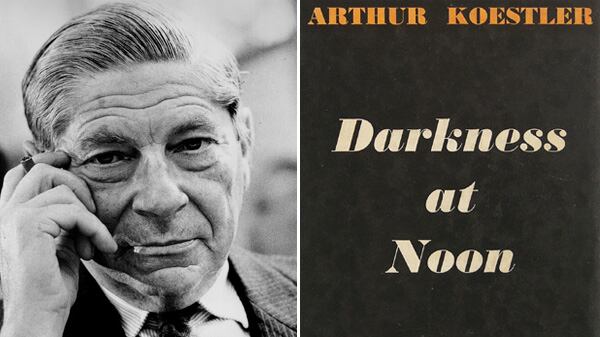
When I last read Darkness at Noon, almost 30 years ago, the Soviet Union was still very much a going concern, although very visibly nearing breakdown. Communism was best described by jokes, including the East German classic: "It is possible to be intelligent. It is possible to be honest. And it is possible to be a communist. But not all three."
Darkness at Noon dragged this 1980s-era reader back to the horrifying time when communism seemed most fully alive. The novel conjured the choking mental atmosphere in which horrible crimes were committed in the name of high ideals. The novel is set in the prison in which the protagonist, N.S. Rubashov, is convinced to participate willingly in his own show trial and ultimate execution. Rubashov is no innocent victim. He has himself coldly sent others to their deaths for political reasons. In one terrible case, he had arranged for the betrayal of a young German communist to Nazi torturers. The young man's offense? He had refused to distribute party propaganda claiming that all was going swimmingly for the party of the workers after the Nazi seizure of power. Instead, he had substituted his own articles acknowledging the crisis and urging a common front with all anti-Nazi elements of German society.
Yet when Rubashov accepts his own death, it is not in a spirit of guilt or atonement. He goes to his death as a final act of faithfulness to the party for which he committed his own crimes. He is convinced to regard his own death as an act of historical necessity - a sacrifice to the Marxist cult of History with a capital "H." The old joke is that Marx turned Hegel on his head, but it might be more true to say that thanks to Hegel, bullets were put inside the heads of thousands of murdered Marxists.
Some historians have criticized Arthur Koestler for misrepresenting the Moscow show trials of the 1930s. It was torture and threats to murder wives and children that extracted confessions from Old Bolsheviks, not the kind of mental gymnastics depicted in Darkness at Noon. If not an accurate account of the trials themselves, however, Darkness at Noon does powerfully explain the mentality that led so many in the West to condone the trials, along with the other atrocities of the Stalin regime. They did so because they believed they were acting for the best in a world that otherwise seemed hopeless.
At a recent luncheon speech, Conrad Black remarked that in the year of his birth, 1944, the world contained only 11 democracies. I won't pretend to have exhausted the almanacs here, but a quick tally suggests he got his number right. I must be missing something, because I can only count 10: the United States, Canada, the United Kingdom, Australia, New Zealand, the Irish republic, Switzerland (where women did not get the vote until 1971), Cost Rica, Chile, and Uruguay. [Twitter reader @omerlev supplies the missing 11th: Sweden]
Darkness at Noon was published in 1940, and it partakes of that impending sense of civilization disappearing beneath the waters. Violence, domination, and the obliteration of the individual human personality seemed to define the present and gave every indication of governing the foreseeable future. Humane individualism seemed a relic of the dead past - or a fantasy for a far-off posterity. The only choices politics appeared to offer were tragic ones.
The perverse idealism that motivated Rubashov and his executioners has not vanished from the planet, far from it. With a few changes of detail, it is very familiar to the jihadist terrorists that trouble the 21st century. What has changed since 1940 is the readership. There remain among us who feel a pang of sympathy for today's murderous ideologues - but not because those sympathizers imagine the murderous ideologues to hold the secrets of the future. The sympathizers sympathize because they romantically imagine the murderous ideologues to hold some connection to a romanticized past - because they perceive them as weak and ultimately pitiable. Whereas in 1940, Soviet sympathizers in the West looked to communism as the last hope of a doomed world, today those very many fewer Westerners who feel sympathy for jihadist terrorism regard jihadism as itself a last stand against an overwhelmingly dominant West. Murderous ideology was once central to world history (with a lower case "h"). Now it is marginal - and what admiration it attracts, it attracts precisely because of its marginality.
I spent some time a little while ago visiting a Middle Eastern country in the company of such sympathizers. They described their cause as "resistance." Resistance to whom - and resistance in the name of what - were never specified. Probably they did not much matter. All attention was focused on the thing resisted. The Ayatollah Khomeini famously called the United States the Great Satan. Bernard Lewis points out that in Islamic theology, Satan is a tempter and seducer. To tempt, one must be tempting; to seduce, one must be seductive - and that one could think of the western world in such terms marks the difference between 1940 and 2012, for all the troubles and difficulties of 2012.
Thanks to reader "dejrabel" for correcting an obvious mistake in the original text.






